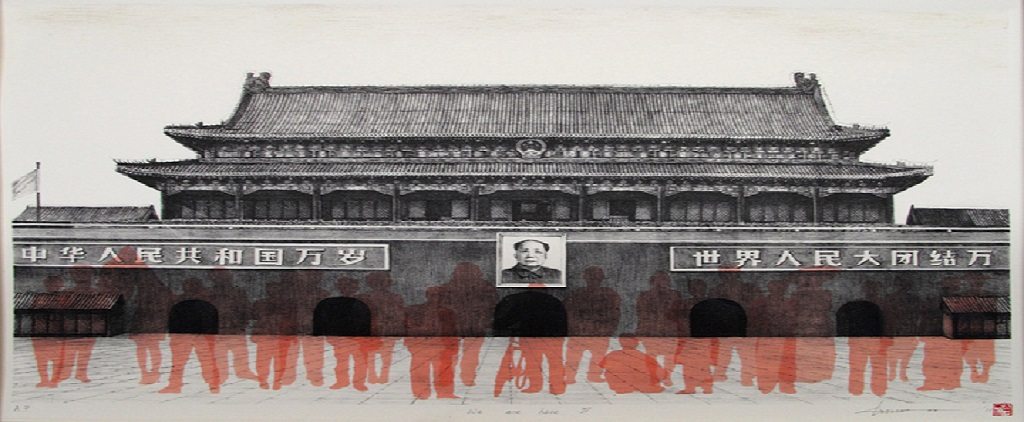[dropcap style=”font-size:100px;color:#992211;”]H[/dropcap]
uge concrete ghosts emerging all over the world haunt developed and developing countries. Like great scars on the landscape, ghost cities remain empty, mocking local populations who will never be able to afford a home and, in some cases, whose settled lives were uprooted to build them! They do though have strange inhabitants: monumental artworks, some anthropomorphic, some figurative and some abstract. These vast works sparsely populate the huge empty cities giving the environment a surreal and liminal quality.
“In just two years, from 2011 to 2012,
China produced more cement than
the United States did in the
entire twentieth century”
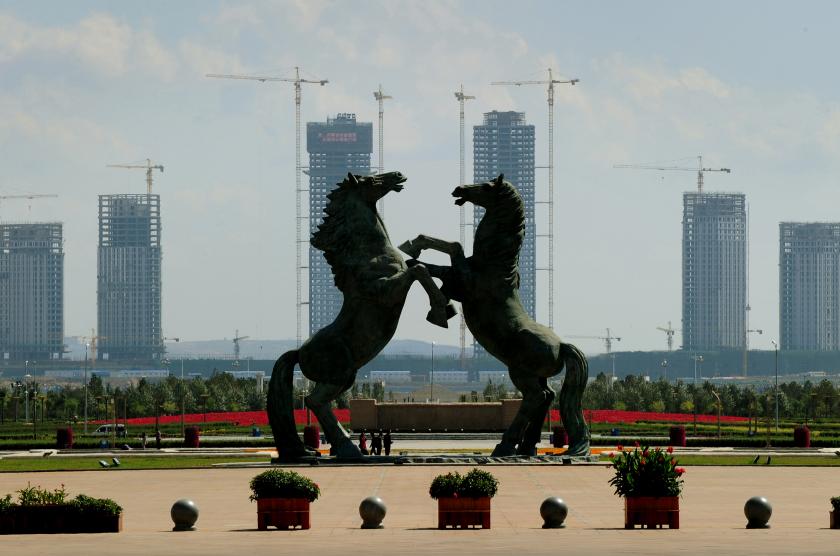
Public sculptures in Ordos, but where’s the public?
The term liminal comes from the Latin, limen, ‘a threshold’, and referred to being in a changing situation. No longer before and not quite after. We are at this stage; these places which for now are essential for driving forward economies exist, and there’s no turning back. China perhaps more than anywhere needs work for the millions of people who come of working age each year and until the government finds a way to provide this by other means, ghost cities will continue to rattle into existence.
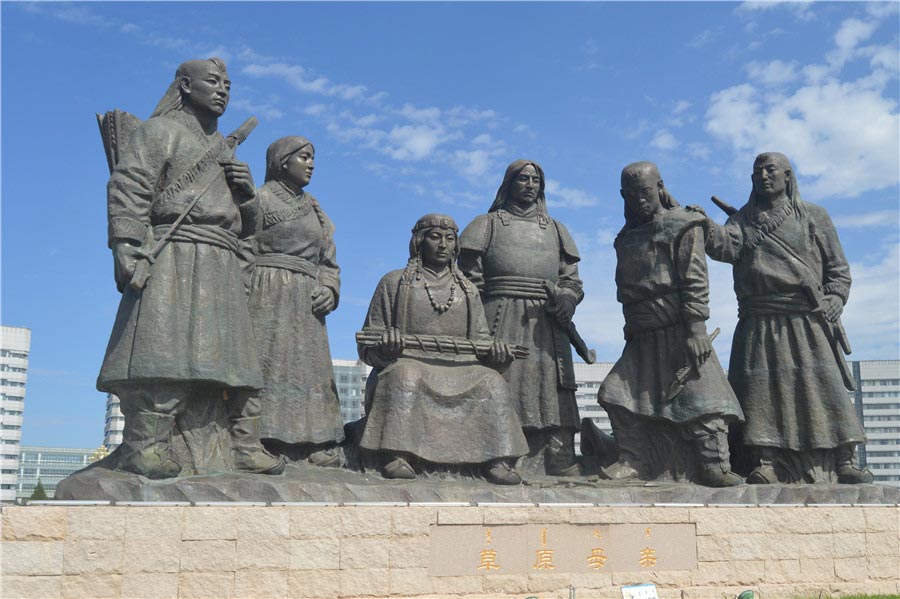
‘Mothers of the Grassland’ by He E, Ordos (North China)
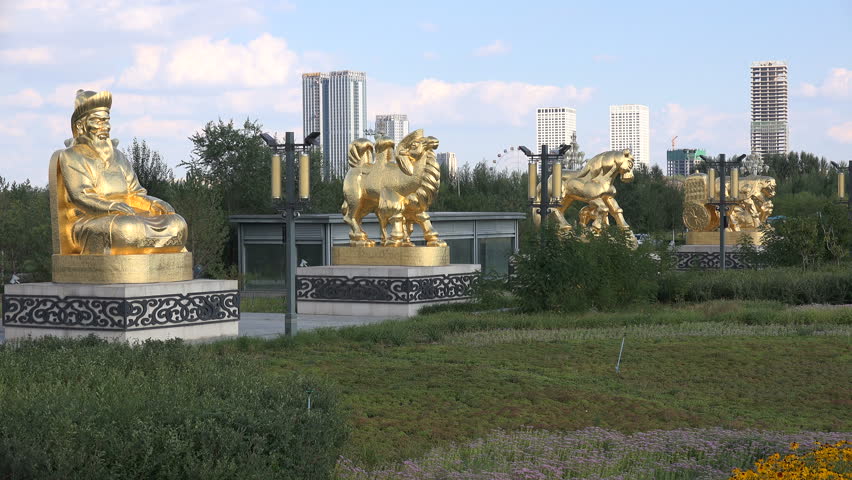
Golden Statues in Ordos
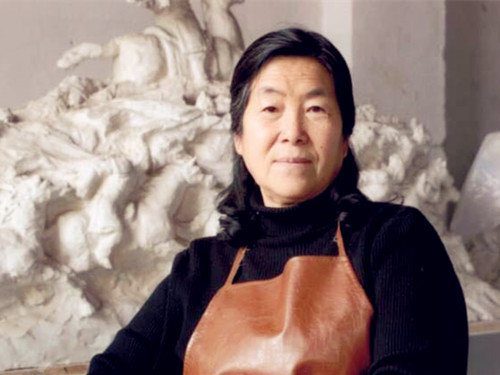
He E The Artist behind many of Ordos’s Sculptures
He E: the celebrated artist of the communist party of China
Like huge art installations, people go to marvel at the vast eerie empty spaces, which in themselves are dreamlike. At present this is co-incidental of course and these places will, in time, be filled with people. What does the work say about the government’s plan for China? The works in Ordos are mainly created by He E, an artist with a long career stretching back to the 1980s.
“He E is from the New China’s first generation of female sculptors. Originally from northwest China’s Gansu Province, the internationally acclaimed artist has racked up a large number of awards including a previous honour as a National March 8 Red-Banner Pacesetter in 1988,”Jane Willborn, ‘He E, women of China’, www.womenofchina.cn
He E is favoured by the CPC (communist party of China) She is a skilful and elegant sculptor who paid her dues working under senior artists in government approved roles and institutions. Her work is neo classical, which is the style of choice for empire-building nations keen to create a grand, imposing, but not too clever form of work. This helps to scaffold the official myths of the culture, part of the glue which the party sees as holding together an otherwise potentially divided people.
Idealisation of figures in Neoclassical sculpture
Of course all nations do this, or have done it, and we need only walk through London to see the austere patriarchs celebrated by Victorians. Just as those figures came out of a huge time of expansion for Britain, so China is expanding across its own continent and in Africa and South America. At the core of this expansion is a conservative taste and need for control. The idealisation of the figures and the scale of the works (monumental, not human) wilfully reject intellectual experimentation, abstraction and otherness, imperfection or difference; instead, they route the underpinning ideology in the values of the totalitarian authority that commissioned them.
Build, Build, Build! Urbanisation and Ghost Cities
Urbanisation is the process by which urban areas grow, are built up or newly created. Historically, as in the industrial revolution, this correlated to the number of people moving to and making their lives in cities: the populations increased and this increased demand for building. This is still a real and pressing driver of the urbanisation which takes place today and is in itself is a problem, especially where populations are displaced by disasters or wars, or where there is a general shortage of space. Whilst his kind of building may be considered a rational reaction to the need for housing, there are other factors which seem to be driving urbanisation and in a surreal twist, large empty buildings are created in many developed and developing countries which never become homes for the many people who need them; the purpose of these projects is the movement of capital.
“This urbanization boom has had very little to do with meeting the needs of people. It has been all about absorbing surplus capital, sustaining profit levels, and maximizing the return on exchange values no matter what the use value demands might be. The consequences have often been irrational in the extreme. While there is a chronic shortage of affordable housing in almost every major city, their skylines are littered with empty condominiums for the ultra-rich whose main interest is in speculating in property values rather than constructing a settled life,”David Harvey, ‘The Crisis of Planetary Urbanization’ 2014, post.at.moma.org
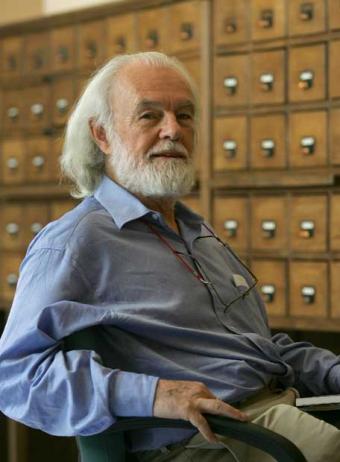
David Harvey in London 2016.
Irrational Times need a Marxist Geographer!
David Harvey1 is a political geographer and anthropologist sometimes referring to himself as a Marxist geographer. Harvey recently expressed his concerns with the trend of urbanisation in general and the counter-intuitive or ‘irrational’ tendency for the building of mega-structures which don’t house the people of the countries who build them. This can be seen in London, where the city is full of empty housing2 and huge unused office blocks which nevertheless sit nicely in the portfolio of large companies and rich private individuals acquiring value. This is exasperated by the sheer number of people who can’t currently and may never be able to afford to buy a home. These places are nicknamed ghost mansions.

Vacant: (Left to right) 39 Charles Street, Mayfair, Cambridge House, Piccadilly, 94 and 95 Park Lane, Mayfair and Athlone House, Highgate (image from www.standard.co.uk)
“Absenteeism as a problem is peculiar to the smudge of “super-prime” London around Harrods (although there are pockets elsewhere, such as Highgate). In a survey by the Empty Homes Agency last year, Kensington and Chelsea was found to have had a 40% annual increase in empty properties, the only area in southern England to show such an increase,” Ed Cumming, ‘Its Like a Ghost Town’ 2015, the Guardian.
The image is extremely odd: as urban areas grow at greater levels than ever before, the spaces for living and the potential to own an adequately sized home decreases.
“According to the United Nations, urban population will increase more than 2.5 billion between 2010 and 2050 in less developed regions, compared to less than 150 million in its more developed regions. By 2050, more than 85 percent of the world’s urbanization is expected to be in today’s less developed regions,” Editor, Urbanization at http://demographicpartitions.org/urbanization-2013/#CfHc3rAxjPiY8CBV.99
“To each his need: from each his power.”
W.H Auden (translating Marx)
but does China really care about
empowering its people?
As we move forward into the coming decades this trend is set to continue; it would even be a difficult issue to manage with a totally rational utilitarian approach. The preferred ‘irrational’ approach of encouraging the speculation of property values to drive the economy is a sure way to both dramatically increase the urbanisation of the planet whilst also increasing the population of the poor, perhaps also making it harder and harder in developed countries for the middle classes, whose numbers have been so increased as a result of these changes, to stabilise their lives.

Rural migrants working in construction in Guangzhou, Freedom Hosue.
“Urbanization has become the centre of overwhelming economic activity on a planetary scale never before seen in human history. The Financial Times reports, for example, that “investment in real estate is the most important driver in the Chinese economy,” which in turn has been the main driver of the global economy throughout the world-wide crisis that began in 2007. “The building, sale and outfitting of apartments accounted for 23 percent of Chinese gross domestic product in 2013.” If we add in the expenditures on massive physical infrastructures (road, rail, public works of all kinds) then close to one half of the Chinese economy is taken up with urbanization,” David Harvey, ‘The Crisis of Planetary Urbanization’ 2014, post.at.moma.org
Paving The World with Concrete
Harvey has recently been reiterating an alarming fact at his lectures and in his written works, one which he feels is oddly under-reported:
“China has consumed more than half of the global steel and cement over the last decade. ‘In just two years, from 2011 to 2012, China produced more cement than the United States did in the entire twentieth century 3 ,” David Harvey, ‘The Crisis of Planetary Urbanization’ 2014, post.at.moma.org
This seems unreal, but not when you consider the phenomenon of ‘Ghost Cities’. These are sometimes entire cities themselves, or areas on the outskirts of existing urban centres which are built and remain empty.
“From shopping malls to soccer stadiums, hundreds of new cities in China are largely empty. And yet more cities are still being built deep in the heart of the country,” Kenneth Rapoza, ‘What Will Become of China’s Ghost Cities?’ 2015, Forbes.
A Better Life, but who for?
Rapoza goes on to say that western media pundits have been in love with the idea of ‘Ghost Cities’ and that this infatuation is a convenient way to bash an economy which has taken more people out of poverty than any other. He also praises the balanced approach of his source, Wade Shepard, author of Ghost Cities of China, who had lived and researched the book while living in China.
“China’s developing its urban architecture three ways: new cities (xinshi), new districts (xinqu) and the so-called townification (chengzhenhua). Townification is quite a departure from the way Chinese cities have developed to date. This is the transformation of small rural centers and even tribal villages and building a small urban center around them. The Communist Party planners in Beijing want to urbanize over 100 million rural Chinese over the next five years alone. That would require the construction of 50 Bostons, or six Shanghais, by 2020,” Kenneth Rapoza, ‘What Will Become Of China’s Ghost Cities?,’ 2015, Forbes.
Stroke of a Pen: the Brutality of Bureaucrats
The sheer using-up of the resources and the general brutality of the way decisions are made by China’s authority is ultimately alarming. The thought of pouring more and more concrete over the landscape to nobody’s benefit except the super rich is an obsession seemingly of all major developed countries.
“In 2010, the governments of Shanghai and Beijing invested nearly $60 billion to bring the World Expo to Shanghai. They kicked people off their land. All told, 18,452 households got eviction notices. Some 270 factories had to move. China’s “stroke-of-a-pen” economy can change fortunes just like that. Those who complained about the relocation program were arrested in typical Chinese fashion. The focus of the Expo was “Better City, Better Life”, but ironically, what it left behind was a ghost town,” Kenneth Rapoza, ‘What Will Become Of China’s Ghost Cities?,’ 2015, Forbes.
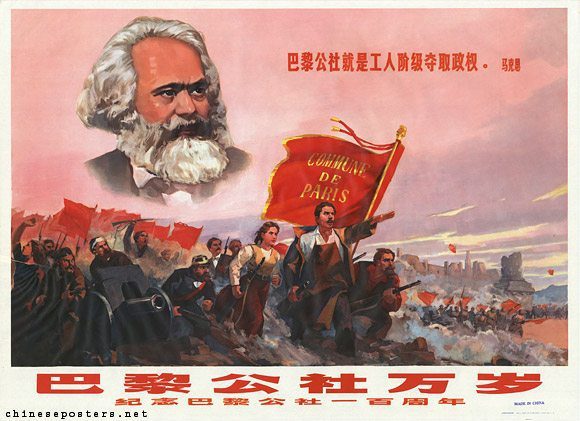
Chinese poster referring to Marx.
Auden translating Marx once said, “To each his need: from each his power.” It’s a beautiful sentiment which has seemingly nothing to do with the way the government in China gets things done. I think both men, Marx and Auden would disapprove of the ‘Better City, Better Life,’ utopianism which requires that the people are run out of an area and that property is valued over life. We too should take heed.
_________________________________________________________________________
Notes
1 Basic information from Wikipedia: David W. Harvey FBA (born 31 October 1935) is the Distinguished Professor of anthropology and geography at the Graduate Center of the City University of New York (CUNY). He received his PhD in geography from the University of Cambridge in 1961. Harvey has authored many books and essays that have been prominent in the development of modern geography as a discipline. He is a proponent of the idea of the right to the city. In 2007, Harvey was listed as the 18th most-cited author of books in the humanities and social sciences in that year, as established by counting cites from academic journals in the Thomson Reuters ISI database. “Most cited authors of books in the humanities, 2007”. Times Higher Education (THE). 2009-03-26. Retrieved 2017-10-10.
2 “Tens of thousands of London homes have been left uninhabited for so long they are considered “long-term vacant” with more than 1,100 of them empty for over a decade, according to data obtained by the Guardian.
Despite a chronic shortage of housing in the capital, more than 22,000 homes have been left empty by their owners for longer than six months, data received from London boroughs in response to freedom of information requests has revealed,” David Pegg, ‘Tens of thousands of London homes deemed long-term vacant’ 2016, Guardian.
3 Harvey cites the following to support his claims, Jamil Anderlini, “Property Sector Slowdown Adds to China Fears,” Financial Times, May 13, 2014 (www.FT.com); Keith Bradsher, “China’s Sizzling Real Estate Market Cools,” New York Times, May 13, 2014, B1.
Title Image: ‘We Are Here’ by Chunwoo Nam

Michael Eden is an artist and researcher working in London and the south east, his artistic practice is concentrated on painting and he divides his time between this and lecturing in art history and contextual studies.

